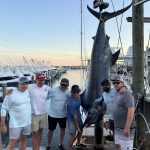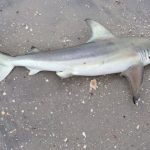ROFFS™ Fishy Times Newsletter – 64th Edition – Updated Videos/Fishing Reports, Oregon Inlet Update, Naming Undersea Features & Global Warming NEWS
Updated Videos on ROFFS™.com – Be Sure to Check Out the “Hot News” Button on the ROFFS™ Homepage
 Above: Flying Sharks! Video Courtesy: Meetville | Facebook
Please click HERE to watch the video on our website now!
Above: Flying Sharks! Video Courtesy: Meetville | Facebook
Please click HERE to watch the video on our website now!
 Above: Now That’s a Bite! Video Courtesy: Outer Banks Sportfishing | Facebook
Please click HERE to watch the video on our website now!
Above: Now That’s a Bite! Video Courtesy: Outer Banks Sportfishing | Facebook
Please click HERE to watch the video on our website now!
 Above: Did He Make it? Video Courtesy: Conhec?a as Ilhas de Angra dos Reis | Facebook
Please click HERE to watch the video on our website now!
Above: Did He Make it? Video Courtesy: Conhec?a as Ilhas de Angra dos Reis | Facebook
Please click HERE to watch the video on our website now!
 Above: Crocodile at Dry Tortugas! Video Courtesy: Kelly Elizabeth Goss | Facebook
Please click HERE to watch the video on our website now!
Above: Crocodile at Dry Tortugas! Video Courtesy: Kelly Elizabeth Goss | Facebook
Please click HERE to watch the video on our website now!
Corps Sending Two Dredges to Reopen Clogged Oregon Inlet Article Courtesy: outerbanksvoice.com | By Rob Morris published on March 30, 2015
Two dredges are steaming to Oregon Inlet to start clearing out the closed channel starting as early as Wednesday.
The sidecast dredge Merritt, which can operate in shallow water, will carve out an 8-foot-deep opening to allow the larger Currituck, a hopper dredge, to do more extensive work, the U.S. Army Corps of Engineers said in a statement Monday.
On Saturday, the U.S. Coast Guard enacted its emergency power to prohibit boats drawing more than 2 feet from motoring within 100 yards of the Bonner Bridge.
Charter boats need 3 to 5 feet and cannot head to sea through the inlet as Easter weekend approaches. There are also only three days left in the lucrative commercial bluefin tuna season.
The Corps recently assumed the power to create a temporary restrictive zone to protect the bridge if necessary, but the Coast Guard also said that the channel was too shallow for its search-and-rescue vessels.
“We recognize the importance of this gateway for vessels traveling in and out of the Oregon Inlet and will continue to do everything possible to re-open the channel,” Donnie Potter, chief of the Physical Support Branch with the Corps’ Wilmington District, said in the statement.
 Above: The hopper dredge Currituck. Image courtesy: outerbanksvoice.com
Please click here to read the latest update on Oregon Inlet, NC from March 30, 2015 on our website now!
Above: The hopper dredge Currituck. Image courtesy: outerbanksvoice.com
Please click here to read the latest update on Oregon Inlet, NC from March 30, 2015 on our website now!
Interested in Naming Undersea Features? Article Courtesy: soundwaves.usgs.gov | By Susan Russell-Robinson originally published November / December 2014
As oceangoing research vessels gather high-resolution elevation data of the seafloor, many opportunities arise to identify new features and to name them. The approval of names falls to the U.S. Board on Geographic Names, a Federal body created in 1890 and established in its present form by Public Law in 1947 to maintain uniform geographic name usage throughout the Federal Government. The Board comprises representatives of Federal agencies concerned with geographic information, population, ecology, and management of public lands. Sharing its responsibilities with the Secretary of the Interior, the Board promulgates official geographic feature names with locative attributes (character, extent, and position) as well as principles, policies, and procedures governing the use of domestic names, foreign names, Antarctic names, and undersea feature names.

Please click here to find out how to officially name an undersea bottom feature on our website now!
Global Warming is Now Slowing Down the Circulation of the Oceans — with Potentially Dire Consequences Article Courtesy: washingtonpost.com | By Chris Mooney originally published March 23, 2015
Last week, we learned about the possible destabilization of the Totten Glacier of East Antarctica, which could unleash over 11 feet of sea level rise in coming centuries.
And now this week brings news of another potential mega-scale perturbation. According to a new study just out in Nature Climate Change by Stefan Rahmstorf of the Potsdam Institute for Climate Impact Research and a group of co-authors, we’re now seeing a slowdown of the great ocean circulation that, among other planetary roles, helps to partly drive the Gulf Stream off the U.S. east coast. The consequences could be dire – including significant extra sea level rise for coastal cities like New York and Boston.
A vast, powerful, and warm current, the Gulf Stream transports more water than “all the world’s rivers combined,” according to the National Oceanic and Atmospheric Administration. But it’s just one part of a larger regional ocean conveyor system – scientists technically call it the “Atlantic meridional overturning circulation” — which, in turn, is just one part of the larger global “thermohaline” circulation (“thermohaline” conjoins terms meaning “temperature” and “salty”).
For the whole system, a key driver occurs in the North Atlantic ocean. Here, the warm Gulf Stream flows northward into cooler waters and splits into what is called the North Atlantic Current. This stream flows still further toward northern latitudes — until it reaches points where colder, salty water sinks due to its greater density, and then travels back southward at depth.
 Above: Graph of the Atlantic Meridional Overturning Circulation by Stefan Rahmstorf from the Potsdam Institute for Climate Impact Research. Red colors are surface currents, blue colors are below the surface. “NADW” stands for North Atlantic Deep Water. Image Courtesy: washingtonpost.com.
Please click here to view more information on how global warming is slowing down the global ocean currents on our website now!
Don’t Forget to Send Us Your Fishing Reports for our Weekly Catch Reports!
Above: Graph of the Atlantic Meridional Overturning Circulation by Stefan Rahmstorf from the Potsdam Institute for Climate Impact Research. Red colors are surface currents, blue colors are below the surface. “NADW” stands for North Atlantic Deep Water. Image Courtesy: washingtonpost.com.
Please click here to view more information on how global warming is slowing down the global ocean currents on our website now!
Don’t Forget to Send Us Your Fishing Reports for our Weekly Catch Reports!
 Above: “Team Jerry Rigged” with a monster wahoo caught offshore of Jacksonville, FL. In the photo from left to right. Craig Williams, Carl Rothman, Jerry Ferranti, and Chris Arrich is taking the picture.
Please click here to view the most recent catch reports on our website now!
Above: “Team Jerry Rigged” with a monster wahoo caught offshore of Jacksonville, FL. In the photo from left to right. Craig Williams, Carl Rothman, Jerry Ferranti, and Chris Arrich is taking the picture.
Please click here to view the most recent catch reports on our website now!
If you do not want to wait for our next Fishy Times newsletter, please visit us in the meantime to get all your fishing news on Facebook, Twitter, YouTube and on the web. Safe and successful fishing until next time! As always, please send comments & feedback on Fishy Times newsletter content directly to us at feedback@roffs.com.
]]>





